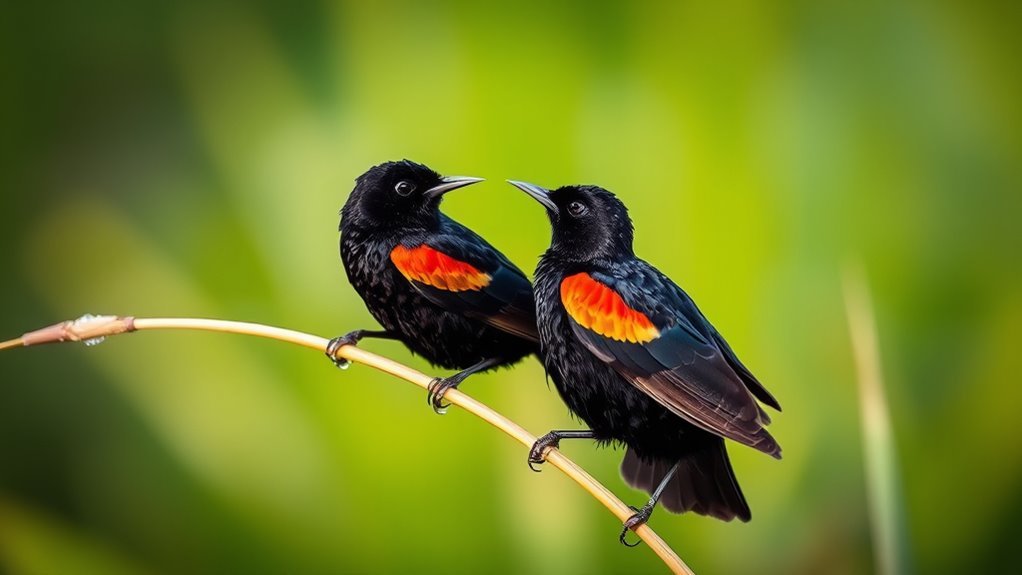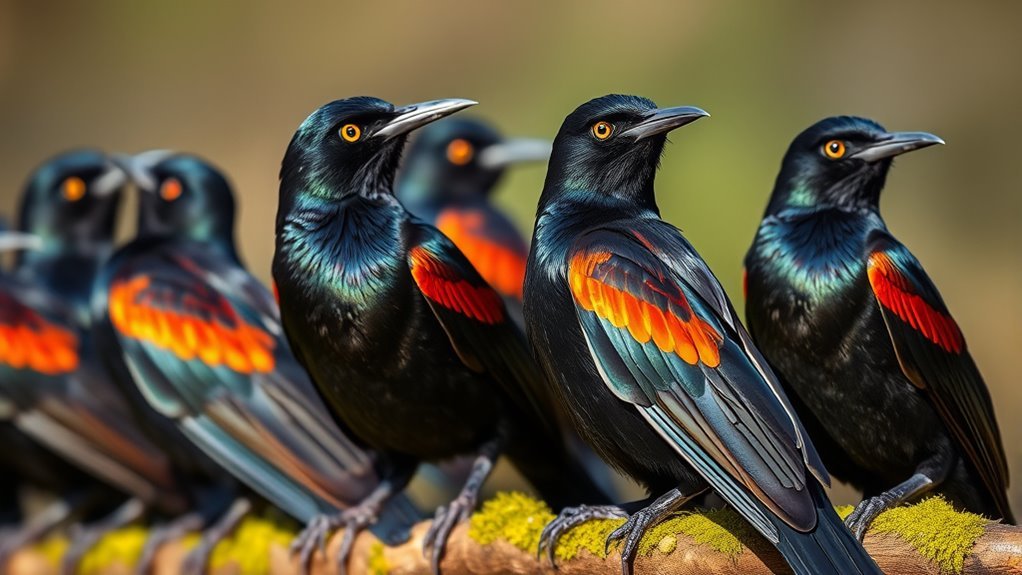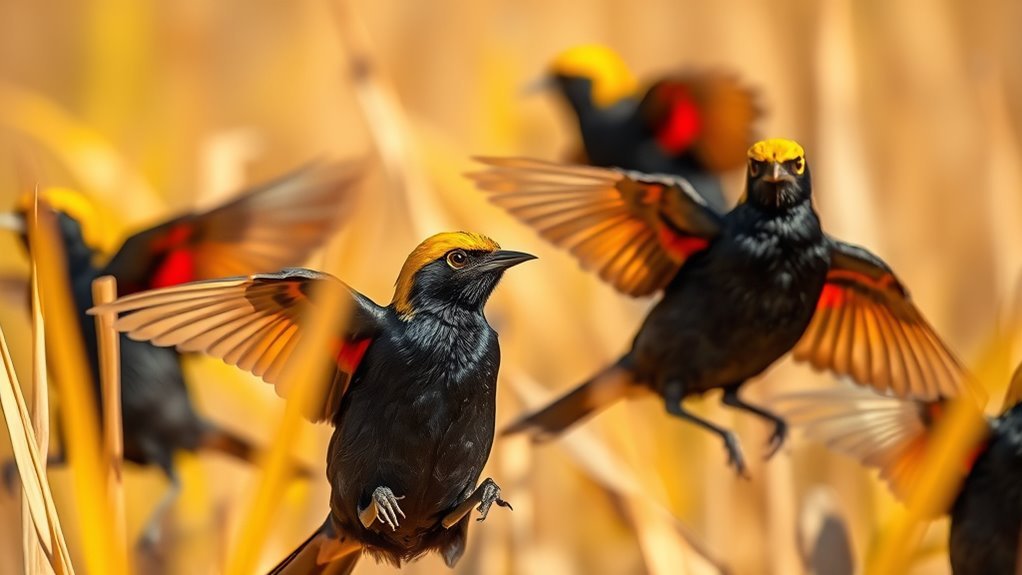Black Birds With Notable Red Wing Patterns
Blackbirds, such as the Red-winged and Tricolored Blackbirds, are known for their bright red wing patterns. These colors attract mates and help defend their territory. Observing these birds can provide valuable insights into their role in the ecosystem. What causes these unique features, and how do they help the birds survive in different environments? Understanding these factors can deepen our appreciation for these beautiful creatures and their place in nature.
Key Takeaways
- The Red-winged Blackbird features bright red and yellow wing patches against a black body, making it easily identifiable.
- The Tricolored Blackbird displays striking black feathers with distinct red and white wing patches.
- Both species inhabit wetlands and grasslands, vital for their breeding and survival.
- These blackbirds are known for their unique social behaviors and territorial displays, particularly during breeding.
- Conservation efforts are essential for protecting their habitats and maintaining healthy populations.
Red-winged Blackbird

When you see a Red-winged Blackbird, the bright red and yellow patches on its shoulders stand out against its black body.
These birds live in wetlands, marshes, and grassy fields, where they build nests in reeds and cattails.
You'll often hear their loud, raspy calls as they mark their territory during the breeding season.
Males are known to defend their area vigorously and show off their bright colors.
In contrast, females have a more muted appearance, which helps them blend in for protection.
Watching these birds and their behaviors can give you valuable insights into their lives and enhance your appreciation for nature and birdwatching.
Eastern Meadowlark
Eastern Meadowlarks are commonly found in open fields and grasslands. Their bright yellow underparts and distinctive black "V" on their chests make them easy to identify.
These birds live in diverse habitats, such as pastures and agricultural areas, where they search for insects and seeds. At sunrise, their clear and melodious song fills the air, creating a beautiful sound in the countryside.
This song is important for attracting mates and defending territory. Watching these birds can deepen your appreciation for nature. It can also connect you with other birdwatchers who enjoy observing avian life.
Common Grackle

The Common Grackle is a blackbird with shiny feathers that display shades of purple and green. This bird lives in many places, such as cities, parks, and farms, making it easy to spot.
Common Grackles are curious and make sounds that resemble whistles. They enjoy being around other grackles, often gathering in large groups, especially during breeding season or while looking for food.
Their diet includes seeds and insects, showing their ability to adapt to different environments. By learning about their habitats and behaviors, you can appreciate how Common Grackles contribute to local ecosystems and feel a connection to these fascinating birds.
Brewer's Blackbird
Brewer's Blackbird is commonly found in open areas across North America. You can identify them by their shiny feathers and bright eye color. They prefer grassy fields, wetlands, and urban spots, showing their ability to adapt to different environments.
These birds often forage in groups, looking for insects, seeds, and food scraps. This social behavior helps build community among them.
During the breeding season, male Brewer's Blackbirds show off their vivid colors and engage in courtship displays to attract females. This behavior highlights their territorial instincts.
Yellow-headed Blackbird

Yellow-headed Blackbirds stand out with their bright yellow heads and black bodies. They live in wetlands, marshes, and grassy areas, where they find food and build nests among cattails and reeds.
These environments are critical for their survival. Unfortunately, habitat loss threatens their population, making conservation efforts vital. Groups work to protect wetlands and restore plants that support these beautiful birds.
You can help by joining local conservation projects or advocating for wetland protection. By learning about their needs and supporting their habitats, you can play a part in helping the Yellow-headed Blackbird thrive.
Rusty Blackbird
Rusty Blackbirds have unique rusty-brown feathers, particularly bright during breeding season. They prefer wet areas like marshes and flooded fields, which offer food and shelter.
Here are some important details about Rusty Blackbirds:
- Habitat: They live in marshes, wetland edges, and flooded fields.
- Diet: They eat insects, seeds, and sometimes aquatic invertebrates.
- Social Behavior: They gather in large flocks, helping them bond as a group.
- Breeding Sites: They build nests in dense vegetation to protect their young.
Learning about these characteristics helps us appreciate the Rusty Blackbird's role in nature.
Red-shouldered Hawk
The Red-shouldered Hawk is a notable bird of prey. It has distinct red shoulder feathers and a sharp call. You often see this hawk near wetlands, forests, and fields. These areas provide good hunting locations.
The hawk hunts small mammals and birds, using soaring and quick dives to catch its prey. You can hear its loud calls in deciduous woodlands, indicating its presence.
As you learn more about this bird, you'll appreciate its adaptability and grace in flight and hunting. The Red-shouldered Hawk adds beauty to its natural habitat, enhancing your connection to wildlife.
Scarlet Tanager
In North America's woodlands, you may see the striking Scarlet Tanager. This bird is known for its bright red feathers and black wings. It prefers specific habitats, such as deciduous forests with dense foliage.
Understanding its migration patterns is essential for wildlife enthusiasts and conservationists. Here are four important points:
- Scarlet Tanagers migrate from Central and South America to North America each year.
- They typically arrive in late spring to breed in temperate forests.
- They like to nest and forage in high canopies.
- Their vivid colors are most visible during the breeding season, making them popular among birdwatchers.
Watching Scarlet Tanagers can enhance your appreciation of nature's beauty.
Black-vented Oriole
The Black-vented Oriole is a stunning bird known for its bright colors and beautiful songs. It attracts birdwatchers in Central America. This bird lives in various environments, such as lowland forests, gardens, and mangroves.
You can often see it searching for fruits and insects in tree canopies, displaying its unique behavior.
The Black-vented Oriole is social and often travels in small flocks. Watching them interact is a joyful experience. Their varied calls add to the sounds of the forest.
Red-winged Starling
The Red-winged Starling is a captivating bird found in Africa. It has striking plumage with bold red wing patterns that attract bird enthusiasts.
These birds live in various habitats, such as:
- Open woodlands
- Grasslands
- Urban areas
- Agricultural fields
The Red-winged Starling is social and often seen in large flocks. This behavior creates a lively atmosphere in their environment.
Their diet includes fruits and insects, showing their ability to adapt to different surroundings. Watching their interactions can help you appreciate their beauty.
Whether you're a dedicated birdwatcher or just curious about wildlife, the Red-winged Starling offers a wonderful glimpse into Africa's rich bird life.
African Red-eyed Bulbul
The African Red-eyed Bulbul has bright feathers and unique red eyes, which attract birdwatchers. This bird thrives in various habitats like forests and gardens.
It's adaptable and often found in pairs or small groups, showcasing its social nature.
The African Red-eyed Bulbul feeds on fruits, nectar, and insects, giving it a varied diet. This flexibility helps it live in different environments.
Watching them move between branches while chirping adds to the joy of birdwatching.
The African Red-eyed Bulbul captivates with its beauty and enhances your love for nature.
Red-billed Quelea
The Red-billed Quelea is a well-known bird in the African savannas. It's famous for its large flocks and colorful feathers. These birds show interesting social behaviors.
- Red-billed Queleas live in grasslands, often near water.
- They form breeding colonies that can have millions of members, showing their group lifestyle.
- Their diet mainly consists of seeds, particularly grasses, which affects their movements.
- Their flight patterns create beautiful shapes in the sky, reflecting their unity.
Learning about the habitats and behaviors of Queleas enhances your appreciation for these birds. It also connects you to the lively ecosystems they support.
Experience the natural rhythms that these amazing birds represent.
Tricolored Blackbird
Blackbirds come in various species, and one interesting type is the Tricolored Blackbird. This bird lives mainly in wetlands and grasslands, where it thrives in its colorful habitat. The Tricolored Blackbird has striking black feathers with red and white patches on its wings, making it visually appealing.
These birds display unique social behaviors and often gather in large flocks, especially during breeding season. They build their nests in dense vegetation, showing a preference for safety and community.
When foraging, they eat a varied diet, including seeds, insects, and grains, depending on what's available.
Learning about the Tricolored Blackbird's habitat and behavior helps us appreciate its role in the ecosystem. This bird contributes to the health of its environment and is a vital part of our wildlife.
Frequently Asked Questions
What Habitats Do Red-Winged Blackbirds Prefer for Nesting?
Red-winged blackbirds prefer to nest in wetlands, marshes, and areas with tall grasses. These habitats offer the cover and resources needed for successful nesting. This protection helps keep their young safe from predators. These environments allow red-winged blackbirds to thrive and raise their families.
How Can I Attract Red-Winged Blackbirds to My Yard?
To attract red-winged blackbirds, arrange your garden with open areas and plant native species. Set up bird feeders filled with seeds and grains near water sources. This will create a welcoming space for the birds.
Additionally, provide a shallow water dish for bathing and drinking. Keep your yard quiet and avoid disturbances to make it a safe spot for these birds. Enjoy watching them as they gather and sing, enriching your garden's atmosphere.
Are Red-Winged Blackbirds Migratory Birds?
Yes, red-winged blackbirds are migratory birds. They typically fly south for the winter and return north in spring. This seasonal movement gives you a chance to see them in different habitats throughout the year.
What Do Red-Winged Blackbirds Eat in Their Diet?
Red-winged blackbirds eat a variety of insects and seeds. They prefer grains like rice and corn, which help maintain their health and support their breeding activities. These food choices are important for their overall well-being and lively behavior.
How Can I Distinguish Male From Female Red-Winged Blackbirds?
To identify male and female red-winged blackbirds, look for size differences. Males are larger than females. Males have unique behaviors such as singing loudly to mark their territory and displaying bold postures. In contrast, females prefer to stay hidden and quietly search for food among the plants. Observing these traits will help you tell them apart easily.

Hello, I’m Amelia White, the founder of birdsfanatic.com. As a lifelong bird enthusiast and spiritual seeker, I’ve always been fascinated by the mystical connections between birds and the human experience. On this site, I share my knowledge and insights into the symbolic meanings and spiritual significance of various bird species, exploring their roles in mythology, folklore, and cultural traditions. Join me on this journey into the world of birds, where we’ll discover the hidden wisdom and guidance that these magnificent creatures have to offer.







